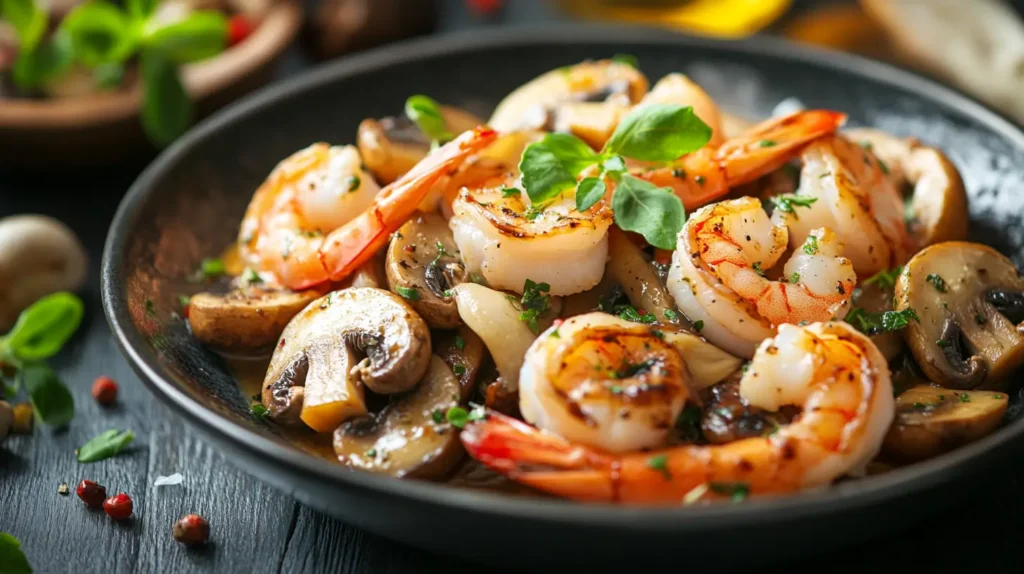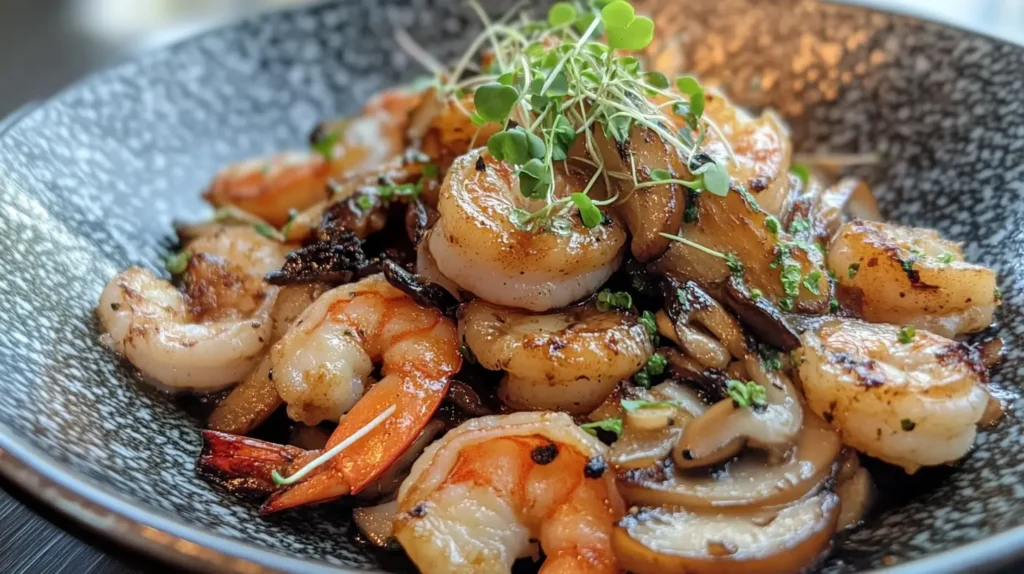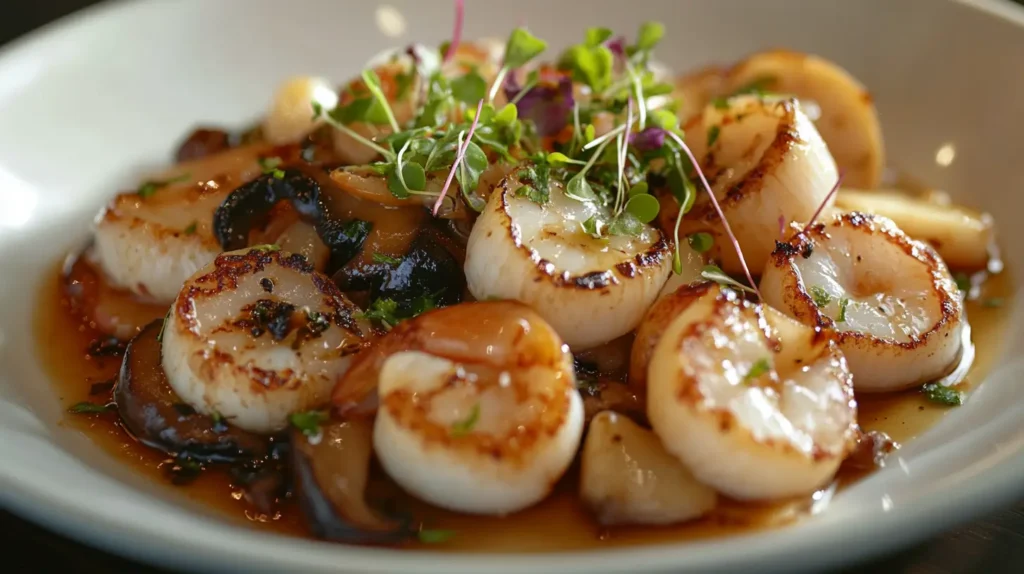Seafood mushroom is a fascinating and versatile ingredient known for its slender white stems and petite caps. Its name originates from its subtle, seafood-like aroma, which pairs well with a variety of flavors. These mushrooms belong to the genus Hypsizygus and are commonly referred to as Shimeji mushrooms.
Unlike many other types of mushrooms, seafood mushrooms maintain a firm texture even when cooked, making them ideal for a variety of dinner recipes. Originating in East Asia, they are now widely available worldwide, thanks to their increasing popularity in both home and professional kitchens.

Table of Contents
Culinary Uses of Seafood Mushroom
Seafood mushrooms are renowned for their adaptability in the kitchen, making them a favorite among chefs and home cooks alike. Their neutral flavor and pleasing texture allow them to blend seamlessly into a variety of dishes, especially for dinner menus.
These mushrooms are excellent for stir-frying, where their crunch provides a delightful contrast to soft vegetables or tender meats. They also work beautifully in creamy sauces, absorbing flavors and enhancing the richness of pasta or risotto dishes.
Popular Dishes Featuring Seafood Mushroom
Dinner recipes featuring seafood mushrooms are as diverse as they are delicious. These mushrooms shine in a variety of dishes, adding both flavor and texture to meals.
- Seafood Mushroom Stir-Fry: A quick and easy dish with vibrant vegetables and a savory sauce.
- Creamy Seafood Mushroom Pasta: A comforting dinner with a luxurious, mushroom-infused sauce.
- Grilled Seafood Mushroom Skewers: Perfect for barbecues, offering a smoky, rich flavor.
- Miso Soup with Seafood Mushroom: A light yet flavorful option that complements traditional Japanese dinners.
- Seafood Mushroom Risotto: A creamy, indulgent dish that showcases the mushroom’s unique characteristics.
Seafood mushrooms is a flavorful dish that pairs perfectly with creative recipes like Vegan Mushroom Recipe or unique dinner ideas like Heart Shaped Pasta. The mushrooms bring a rich, earthy texture that complements various ingredients, making them versatile for multiple dishes.

Seafood Mushroom in Global Cuisines
Seafood mushrooms play a significant role in dinner recipes across global cuisines, thanks to their universal flavor profile and versatility. In East Asia, they are a staple in hot pots, stir-fries, and soups, blending harmoniously with the bold flavors of soy sauce, sesame oil, and chili.
European cuisines have embraced seafood mushrooms in risottos, creamy sauces, and roasted vegetable medleys. In fusion cooking, they appear in tacos, flatbreads, and pizzas, offering a new twist to traditional recipes. Even Middle Eastern dishes are beginning to incorporate these mushrooms into tagines and savory pies.
How to Select and Store it
Selecting and storing seafood mushrooms correctly is crucial for preserving their freshness and flavor. When purchasing, look for mushrooms with firm, white stems and smooth caps. Avoid any with discoloration, slimy texture, or an off smell.
To store, place seafood mushrooms in a paper bag or breathable container in the refrigerator. Proper storage keeps them fresh for up to a week, though using them sooner ensures the best flavor and texture. Avoid washing them until just before cooking, as excess moisture can lead to spoilage. With these tips, your seafood mushrooms will be ready for any dinner recipe you have in mind.
Tips for Cooking
Cooking seafood mushrooms is straightforward, but a few tips can elevate your dishes.
- Always rinse them lightly to remove any debris, but avoid soaking as they absorb water quickly.
- Pair them with complementary ingredients like garlic, ginger, or fresh herbs to enhance their subtle flavor.
- Cook on medium heat to prevent over-softening and maintain their pleasant crunch.
Growing Your Own Seafood Mushroom at Home
Growing seafood mushrooms at home is a rewarding experience that ensures a constant supply of this culinary delight. All you need is a mushroom-growing kit or basic materials like sawdust, substrate, and spawn.
Keep the growing medium moist and place it in a well-ventilated, shaded area. Within a few weeks, you’ll have fresh seafood mushrooms ready to harvest. This method is not only cost-effective but also ensures the mushrooms are free of chemicals, providing a fresh ingredient for your dinner recipes.

The Role in Sustainable Cuisine
Seafood mushrooms are a sustainable choice for dinner recipes, aligning with environmentally conscious cooking. Their cultivation requires minimal water and space, reducing their ecological footprint. Additionally, they grow on agricultural by-products like sawdust, promoting waste reduction.
Seafood Mushroom in Asian Cuisine
Asian cuisine highlights the natural flavor of seafood mushrooms, making them a cherished ingredient. In Chinese dishes, they appear in stir-fries with oyster sauce and garlic. Japanese recipes use them in soups, tempura, and hot pots, while Korean meals incorporate them into spicy stews and savory pancakes.
These regional specialties showcase the versatility of seafood mushrooms, making them an essential ingredient for authentic Asian dinners.
Incorporating Seafood Mushroom in Fusion Recipes
Fusion recipes featuring seafood mushrooms combine flavors from various cuisines to create innovative dinners. Imagine mushroom tacos with a spicy Asian glaze, or flatbreads topped with roasted seafood mushrooms and Mediterranean herbs.
Such recipes reflect the versatility of seafood mushrooms, offering endless possibilities for creative and exciting dinners that cater to diverse tastes.
How to Prepare This Recipes
Preparation is key to making the most of seafood mushrooms in your dinner recipes. Begin by trimming the base and separating the stems. Rinse them briefly under cold water to remove dirt but pat them dry immediately to prevent sogginess.
Depending on the recipe, you can leave them whole for visual appeal or chop them for even cooking. Proper preparation ensures seafood mushrooms integrate seamlessly into your dishes, enhancing both taste and texture.
Common Cooking Techniques
Seafood mushrooms are versatile and adapt well to various cooking methods, making them a staple for dinner recipes. Stir-frying is a popular choice, as it retains their crunch and infuses them with the flavors of accompanying ingredients. Sautéing with garlic and butter is another classic technique that enhances their natural umami.
For deeper flavors, simmering seafood mushrooms in sauces or broths allows them to soak up seasonings. Roasting brings out their nutty undertones, while steaming preserves their subtle taste and delicate texture. Each technique highlights different aspects of seafood mushrooms, ensuring they can elevate any dinner dish.
Seafood Mushroom in Soups and Stews
Seafood mushrooms shine in soups and stews, offering a satisfying texture and a mild, earthy flavor that complements broths and hearty ingredients. In clear broths, they provide a subtle seafood-like aroma, while in creamy soups, their chewy texture creates balance.
They pair well with proteins like chicken or tofu and add depth to vegetable-based stews. Whether used in a miso soup or a rich curry, seafood mushrooms absorb the surrounding flavors, enhancing every bite. Their ability to hold their shape during cooking makes them a reliable and delightful choice for warm, comforting dinner bowls.
Grilling and Roasting
Grilling and roasting seafood mushrooms are excellent ways to bring out their smoky, nutty flavor. When grilling, skewering them with vegetables or meats ensures even cooking and creates a visually appealing dinner presentation.
For roasting, tossing seafood mushrooms with olive oil, garlic, and herbs yields crispy edges and a tender interior. These methods intensify their flavor, making them a standout ingredient for side dishes or as the main star of a dinner platter. Both techniques require minimal preparation, making them ideal for quick, flavorful meals.
Seafood Mushroom in Vegetarian and Vegan Cooking
Seafood mushrooms are a favorite in vegetarian and vegan dinners, thanks to their meaty texture and umami profile. They serve as an excellent substitute for animal proteins in stir-fries, curries, and pasta dishes.
In vegan dishes, they can be grilled or roasted to replicate the satisfying chewiness of meat. Their ability to absorb seasonings and sauces ensures they fit seamlessly into plant-based meals, from creamy risottos to savory pies. For vegetarians, they complement cheese-based recipes like quiches and gratins, adding both flavor and substance.
Seafood Mushroom Substitutes in Recipes
When seafood mushrooms aren’t available, several substitutes can maintain the integrity of your dinner recipes. King oyster mushrooms are a close match, offering a similarly firm texture and mild flavor. Enoki mushrooms, while more delicate, can replicate their appearance in dishes like soups and stir-fries.
For recipes requiring a more robust flavor, shiitake mushrooms provide an earthy alternative. Portobello mushrooms can also serve as a substitute in recipes where size and heartiness are desired. Adjusting cooking techniques slightly will ensure these replacements deliver the same satisfaction as seafood mushrooms.
How to Use Seafood Mushroom in Quick and Easy Meals
Seafood mushrooms are perfect for quick and easy dinners that don’t compromise on flavor. Toss them into a stir-fry with fresh vegetables and a savory sauce for a 15-minute meal. Add them to instant ramen or noodle bowls for extra texture and depth.
In pasta dishes, roasted seafood mushrooms with garlic and olive oil creates a simple yet delicious topping. For a light dinner, roast them with herbs and pair them with a fresh salad. Their adaptability and minimal preparation time make them a go-to choice for busy weeknights.
FAQs
What is seafood mushroom used for?
Seafood mushroom is used in a variety of dishes to add texture, flavor, and visual appeal. Its mild umami taste and seafood-like aroma make it a versatile ingredient in stir-fries, soups, stews, pastas, and casseroles. It’s especially popular in Asian cuisines, where it is included in hot pots and broths. Beyond traditional recipes, seafood mushrooms are also used in fusion dishes, such as tacos and flatbreads, due to their ability to absorb seasonings and complement a wide range of flavors.
Is seafood mushroom the same as enoki?
No, seafood mushroom is not the same as enoki. While both are edible fungi with slender stems, seafood mushrooms (also known as white beech mushrooms or shimeji) have a firmer texture, slightly thicker stems, and rounded caps. Enoki mushrooms, on the other hand, have very thin, delicate stems and small, tightly packed caps. The flavors also differ, with seafood mushrooms having a mild, nutty taste and enoki being more neutral.
What mushroom tastes like seafood?
Seafood mushrooms are named for their subtle seafood-like aroma and mild flavor, making them the go-to mushroom for dishes seeking that characteristic. Other mushrooms that can mimic a seafood-like taste include oyster mushrooms, which have a slightly briny flavor, and lion’s mane mushrooms, known for their crab- or lobster-like texture and taste when cooked.
What is the white mushroom that looks like enoki?
The white mushroom that resembles enoki but has a slightly thicker stem and rounder cap is the seafood mushroom, also called white beech mushroom or Shimeji. Unlike enoki, seafood mushrooms are more robust and maintain their texture better during cooking, making them ideal for stir-fries, soups, and roasted dishes. Their appearance is similar, but their culinary uses and characteristics differ significantly.
Conclusion
Seafood mushrooms are a versatile and delightful ingredient that can transform dinner recipes with their unique texture and flavor. From soups and stews to grilled and roasted dishes, their adaptability ensures they fit seamlessly into any culinary style.
Whether you’re exploring vegetarian and vegan meals or experimenting with global cuisines, seafood mushrooms bring a touch of elegance and satisfaction to the table. Their ease of use and ability to absorb flavors make them a must-have for creative and delicious dinners. With their sustainability and wide availability, there’s every reason to make seafood mushrooms a staple in your kitchen.
